Ice Flexural Properties Using Four-Point Bending Test for the Ice Runway at Huhenuoer Lake
Abstract
1. Introduction
2. Natural Conditions, Ice Properties, and Four-Point Bending Test
2.1. Basic Huhenuoer Lake Natural Conditions
2.2. Observed Fundamental Properties of the Huhenuoer Lake Ice
2.3. Four-Point Bending Test Method
3. Test Results and Analysis of Ice Flexural Properties
3.1. Four-Point Bending Test Results
3.2. Effect of Ice Temperature on Bending Mechanical Properties
3.3. Effect of Ice Porosity on Bending Mechanical Properties
4. Design Parameters of Huhenuoer Lake Ice Runway
5. Conclusions and Perspectives
5.1. Conclusions
- The average grain size of the Huhenuoer Lake ice is around 15.88 mm. The grain figure indicates that the Huhenuoer Lake ice consists entirely of columnar ice, with grain size exhibiting a pattern of increasing with depth. The average density of Huhenuoer Lake ice is about 0.89 g/cm3. The density of Huhenuoer Lake ice has a decreasing trend with depth until stabilizing. Analysis of all test specimens from the four-point bending experiment yielded an average effective flexural elastic modulus of 3.31 GPa. The average flexural strength is about 2813 kPa.
- The effective flexural elastic modulus and flexural strength increase as temperature decreases. This research used Equation (5) (logarithmic function) to model the inverse relationship between flexural strength and temperature. Equation (6) (linear function) characterizes the inverse association between effective flexural elastic modulus and temperature. The influence of temperature on the effective flexural elastic modulus and flexural strength may be attributed to the fact that lower ice temperatures enhance intermolecular bonding forces, necessitating more energy to initiate fractures, hence strengthening the flexural strength and effective flexural elastic modulus of ice.
- The effective flexural elastic modulus and flexural strength decrease as porosity increases. This research used Equation (7), a composite function of the exponential and power functions, to model the inverse relationship between flexural strength and porosity. Equation (8) (power function) characterizes the inverse relationship between the effective flexural elastic modulus of bending and porosity. The impact of porosity on the effective flexural elastic modulus and flexural strength may be analyzed from three perspectives: 1. The flexural strength of air is significantly inferior to that of pure ice, and variations in the volume of bubbles and pure ice crystals influence the mechanical properties of the entire ice layer; 2. Structurally, differences in bubble size and position within an ice layer of equivalent bubble content will also influence the overall mechanical performance of lake ice; 3. During failure, pores within the ice will induce stress concentration phenomena, resulting in elevated stress regions surrounding the bubbles. Consequently, it results in inter-crystal or trans-crystal dislocation and slip. As a result, it affects the flexural mechanical properties of lake ice.
- Utilizing the analytical methodology proposed by Wang et al. [4], and considering that the design air temperature in cold-region engineering serves as a conservative indicator reflecting how “warm” the winter season can be, this study first analyzed the daily mean air temperatures during the conservative operational periods of different aircraft types from 1993 to 2024. For each aircraft type, the average value and standard deviation of the daily mean air temperatures within its respective conservative operational periods were calculated. The sum of these two values—the average plus one standard deviation—was then defined as the design air temperature for the aircraft in this study. Based on this design air temperature, the corresponding design ice temperature was obtained by averaging the design air temperature and the ice–water interface temperature, under the assumption of a linear vertical temperature distribution within the ice cover. The subsequent steps for determining the design flexural strength and the design effective flexural elastic modulus are summarized in Figure 7. Specifically, the design ice temperature derived above is used to calculate the design flexural strength according to Equation (5), and the design effective flexural elastic modulus according to Equation (6). Following this procedure, the design ice temperature of the An-2 aircraft at the potential Huhenuoer Lake ice runway was determined to be −9.8 °C, corresponding to a design flexural strength of 2800 kPa and a design effective flexural elastic modulus of 3.24 GPa. The same analytical process was applied to the Bombardier Q400 and Gulfstream G650ER to derive their respective design values.
5.2. Perspectives
Author Contributions
Funding
Data Availability Statement
Conflicts of Interest
Appendix A. Schematic Diagram of the Mechanical Analysis for the Four-Point Bending Test

Appendix B. Force–Deflection Behavior of Ice Beams
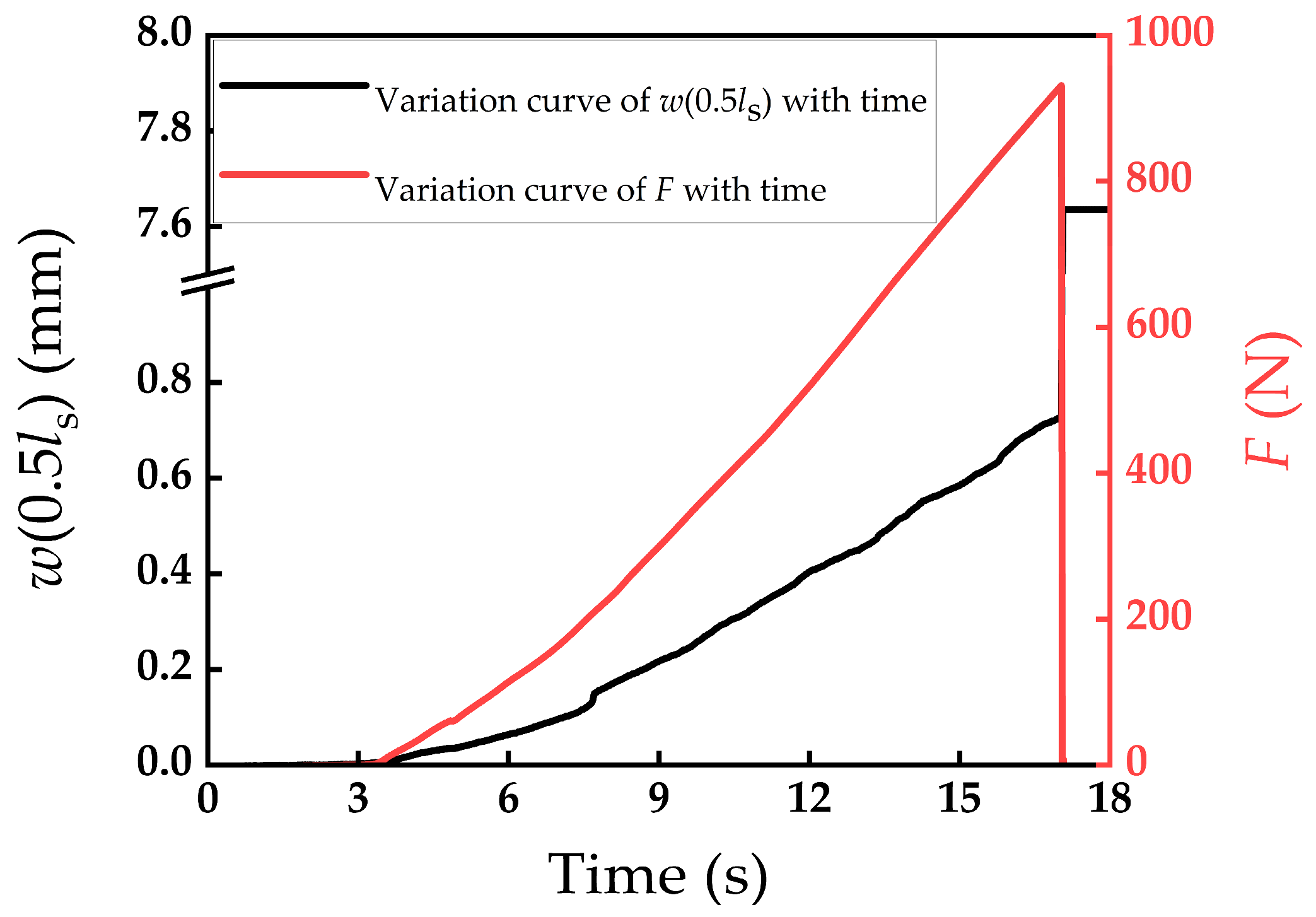
Appendix C. Two Representative Experimental Results to Illustrate the Fracture Location of Ice Beams

Appendix D. The Specific Strain Rate and Loading Time for Each Specimen
| Test Number | Loading Time | Test Number | Loading Time | ||
|---|---|---|---|---|---|
| 1 | 2.24 | 18 | 26 | 3.23 | 19 |
| 2 | 2.24 | 25 | 27 | 2.21 | 17 |
| 3 | 3.27 | 14 | 28 | 2.24 | 13 |
| 4 | 4.34 | 8 | 29 | 3.26 | 11 |
| 5 | 4.13 | 8 | 30 | 4.55 | 12 |
| 6 | 3.27 | 14 | 31 | 3.24 | 10 |
| 7 | 4.54 | 9 | 32 | 3.30 | 10 |
| 8 | 2.20 | 14 | 33 | 3.33 | 9 |
| 9 | 4.62 | 9 | 34 | 4.22 | 12 |
| 10 | 2.20 | 20 | 35 | 4.40 | 9 |
| 11 | 3.20 | 12 | 36 | 3.16 | 11 |
| 12 | 3.30 | 13 | 37 | 3.33 | 6 |
| 13 | 4.36 | 10 | 38 | 4.41 | 8 |
| 14 | 3.34 | 16 | 39 | 3.36 | 16 |
| 15 | 2.22 | 23 | 40 | 2.21 | 19 |
| 16 | 2.15 | 16 | 41 | 3.24 | 40 |
| 17 | 4.47 | 11 | 42 | 4.37 | 16 |
| 18 | 2.24 | 32 | 43 | 2.24 | 22 |
| 19 | 2.15 | 14 | 44 | 4.45 | 10 |
| 20 | 4.46 | 13 | 45 | 2.16 | 6 |
| 21 | 3.35 | 13 | 46 | 2.2 | 23 |
| 22 | 3.28 | 11 | 47 | 4.38 | 11 |
| 23 | 4.46 | 7 | 48 | 3.37 | 11 |
| 24 | 4.53 | 9 | 49 | 4.11 | 12 |
| 25 | 4.37 | 9 | 50 | 2.23 | 24 |
Appendix E. Method of Ice Thickness Required by Different Aircraft Types and Conservative Operation Time Period in a Certain Year

References
- Goldstein, R.; Leppäranta, M.; Onishchenko, D.; Osipenko, N. Bearing Capacity of Ice. Available online: https://www.eolss.net/ebooklib/bookinfo/cold-regions-science-marine-technology.aspx# (accessed on 16 September 2025).
- Babaei, H.; Barrette, P.D. A Computational Modeling Basis in Support of the Canadian Winter Road Infrastructure; Technical Report; NRC-OCRE-2020-TR-007; National Research Council Canada: Ottawa, ON, Canada, 2020.
- Wang, Q.; Li, Z.; Lu, P. Engineering Applications of Sea Ice Physical and Mechanical Properties: A Case Study on Unloading Cargos on Ice in the Antarctic. Ship Boat 2023, 34, 137–142. (In Chinese) [Google Scholar] [CrossRef]
- Wang, Y.; Zhao, Q.; Zhang, B.; Wang, Q.; Lu, P.; Wang, Q.; Bao, X.; He, J. An Investigation of the Thickness of Huhenuoer Lake Ice and Its Potential as a Temporary Ice Runway. Water 2025, 17, 400. [Google Scholar] [CrossRef]
- Huang, W. Study on Lake Ice Microstructure and Its Effects on Thermal and Mechanical Parameters. Ph.D. Thesis, Dalian University of Technology, Dalian, China, 2013. (In Chinese). [Google Scholar]
- Gow, A.J.; Ueda, H.T.; Ricard, J.A. Flexural Strength of Ice on Temperate Lakes: Comparative Tests of Large Cantilever and Simply Supported Beams; CRREL Report 78-9; U.S. Army Cold Regions Research and Engineering Laboratory: Hanover, NH, USA, 1978. [Google Scholar]
- Gow, A.J. Orientation Textures in Ice Sheets of Quietly Frozen Lakes. J. Cryst. Growth 1986, 74, 247–258. [Google Scholar] [CrossRef]
- Weeks, W.F.; Assur, A. Fracture of Lake and Sea Ice; CRREL Research Report 269; U.S. Army Cold Regions Research and Engineering Laboratory: Hanover, NH, USA, 1969. [Google Scholar]
- Gow, A.J.; Langston, D. Flexural Strength of Lake Ice in Relation to Its Growth Structure and Thermal History; CRREL Research Report 349; U.S. Army Cold Regions Research and Engineering Laboratory: Hanover, NH, USA, 1975. [Google Scholar]
- Frankenstein, G.E. Strength Data on Lake Ice; Technical Report 80; U.S. Army Snow Ice and Permafrost Research Establishment, Corps of Engineers: Wilmette, IL, USA, 1961. [Google Scholar]
- Han, H.; Jia, Q.; Huang, W.; Li, Z. Flexural Strength and Effective Modulus of Large Columnar-grained Freshwater Ice. J. Cold Reg. Eng. 2016, 30, 04015005. [Google Scholar] [CrossRef]
- Cole, D.M. The Microstructure of Ice and Its Influence on Mechanical Properties. Eng. Fract. Mech. 2001, 68, 1797–1822. [Google Scholar] [CrossRef]
- Suominen, M.; Repin, R.; Lu, L.; Li, F.; Kujala, P. Flexural Strength of Freshwater Ice in Saimaa Area. In Proceedings of the 26th International Conference on Port and Ocean Engineering Under Arctic Conditions, Moscow, Russia, 14–18 June 2021. [Google Scholar]
- Yang, L. Research on the Problems and Countermeasures in the Development of Tourism in Hulunbeier City. Master’s Thesis, Harbin Institute of Technology, Harbin, China, 2015. (In Chinese). [Google Scholar]
- Antarctic and Southern Ocean Coalition (ASOC). Land-based Tourism in Antarctica. In Proceedings of the Buenos Aires: XXXIV Antarctic Treaty Consultative Meeting (ATCM 34), Buenos Aires, Argentina, 20 June–1 July 2011. [Google Scholar]
- Zhou, C.; Xie, Y.; Zhang, A.; Liu, C.; Yang, J. Spatiotemporal Analysis of Interactions Between Seasonal Water, Climate, Land Use, Policy, and Socioeconomic Changes: Hulun-Buir Steppe as a Case Study. Water Res. 2022, 209, 3541. [Google Scholar] [CrossRef]
- Zhang, J. Study on the Fuel Moisture Codes and Dynamic of Fuel Moisture Content in Jiagedaqi and Fuyuan. Ph.D. Thesis, Northeast Forestry University, Harbin, China, 2018. (In Chinese). [Google Scholar]
- Editorial Committee of Encyclopedia of Rivers and Lakes in China. Encyclopedia of Rivers and Lakes in China: Section of Heilong River and Liaohe River Basins; China Water & Power Press: Beijing, China, 2014; p. 17. (In Chinese) [Google Scholar]
- Bedogni, V.; Manes, A. An Experimental Investigation of the Effect of the Placement Angle on the Collapse of Ice Screw Anchors. Eng. Fail. Anal. 2021, 26, 139–150. [Google Scholar] [CrossRef]
- Zhang, Y. Study on Internal Fabric Characteristics and Compressive Mechanical Properties of the Frazil Ice. Ph.D. Thesis, Dalian University of Technology, Dalian, China, 2024. (In Chinese). [Google Scholar] [CrossRef]
- Wu, G.; Tang, W.; Wang, Q.; Zhao, Y.; Ma, Q.; Li, Z. Full-scale Ice Trials of R/V Xuelong 2 during Her Maiden Antarctic Voyage. J. Ship Mech. 2021, 25, 981–990. (In Chinese) [Google Scholar]
- Zhang, Y.; Qian, Z.; Lv, S.; Huang, W.; Ren, J.; Fang, Z.; Chen, X. Experimental Investigation of Uniaxial Compressive Strength of Distilled Water Ice at Different Growth Temperatures. Water 2022, 14, 4079. [Google Scholar] [CrossRef]
- Huo, P.; Lu, P.; Leppäranta, M.; Kirillin, G.; Cheng, B.; Xie, F.; Li, Z. Strong Under-ice Heating of Central Asian Shallow Lakes. Geophys. Res. Lett. 2025, 52, e2024GL114501. [Google Scholar] [CrossRef]
- Huo, P.; Lu, P.; Cheng, B.; Yu, M.; Wang, Q.; Li, X.; Li, Z. Reconstructing Ice Phenology of a Lake with Complex Surface Cover: A Case Study of Lake Ulansu during 1941–2023. Cryosphere 2025, 19, 849–868. [Google Scholar] [CrossRef]
- Hutchings, J.K.; Heil, P.; Lecomte, O.; Stevens, R.; Steer, A.; Lieser, J.L. Comparing Methods of Measuring Sea-ice Density in the East Antarctic. Ann. Glaciol. 2015, 56, 77–82. [Google Scholar] [CrossRef]
- Wang, Q. Study on the Physical and Mechanical Engineering Parameters of Sea Ice During Melt Season for Arctic Passage. Ph.D. Thesis, Dalian University of Technology, Dalian, China, 2019. (In Chinese). [Google Scholar]
- Han, H.; Li, W.; Li, Y.; Liu, Z.; Liu, X. An Experimental Investigation of the Flexural Strength and Fracture Toughness of Granular Snow Ice Under a Three-Point Bending Test. Water 2024, 16, 3358. [Google Scholar] [CrossRef]
- Aly, M. Analysis of Scale Effects in Ice Flexural Strength. Master’s Thesis, Memorial University of Newfoundland, St. John’s, NL, Canada, 2018. [Google Scholar]
- Weeks, W.F.; Assur, A. The Mechanical Properties of Sea Ice. In US Army Cold Regions Research and Engineering Laboratory (CRREL) Monograph II-C3; Cold Regions Research and Engineering Laboratory: Hanover, NH, USA, 1967. [Google Scholar]
- Aly, M.; Taylor, R.; Bailey Dudley, E.; Turnbull, I. Scale Effect in Freshwater Ice Flexural Strength. In Proceedings of the ASME 2018 37th OMAE Conference, Madrid, Spain, 17–22 June 2018. [Google Scholar]
- Sun, J. Bending Test of Ice Beam and Analysis of Mechanic Performance of Ice Shell. Master’s Thesis, Harbin Institute of Technology, Harbin, China, 2019. (In Chinese). [Google Scholar]
- Kermani, M.; Farzaneh, M. Flexural and Low-cycle Fatigue Behavior of Atmospheric Ice. J. Mater. Sci. 2009, 44, 2497–2506. [Google Scholar] [CrossRef]
- Timco, G.W.; Weeks, W.F. A Review of the Engineering Properties of Sea Ice. Cold Reg. Sci. Technol. 2010, 60, 107–129. [Google Scholar] [CrossRef]
- Cox, G.F.N.; Weeks, W.F. Equations for Determining the Gas and Brine Volumes in Sea-Ice Samples. J. Glaciol. 1983, 29, 306–316. [Google Scholar] [CrossRef]
- Ji, S.; Liu, Y.; Wang, Q.; Lu, P.; Yuan, S. In Situ Tests on the Flexural Strength and Effective Elastic Modulus of Brackish Ice During Different Ice Periods. Water 2025, 17, 3189. [Google Scholar] [CrossRef]
- Wang, L. Experimental Study on Bending Performance of Artificial Ice and Numerical Simulation Analysis of Artificial Ice Rink. Master’s Thesis, Harbin Institute of Technology, Harbin, China, 2021. (In Chinese). [Google Scholar] [CrossRef]
- Koshkin, S.V.; Taranukha, N.A. Physical and Mechanical Properties of Sea Ice in Bending. In Proceedings of the ASRTU Conference Proceedings, IV Sino-Russian ASRTU Symposium on Advanced Materials and Processing Technology, Ekaterinburg, Russia, 23–26 June 2016. [Google Scholar]
- Xiu, Y. Study on Sea Ice Design Parameters for Ship Ice Resistance Evaluation in the Arctic Ocean. Ph.D. Thesis, Dalian University of Technology, Dalian, China, 2023. (In Chinese). [Google Scholar]
- Scher, R.L. Alaska Air Temperature Indices—Design ‘Warm’ Winter. In Cold Regions Engineering: Cold Regions Impacts on Transportation and Infrastructure, Proceedings of the 11th International Conference on Cold Regions Engineering 2002, Anchorage, AK, USA, 20–22 May 2002; American Society of Civil Engineers: Anchorage, AK, USA, 2002; pp. 700–711. [Google Scholar]
- Leppäranta, M. Ice Phenology and Thickness Modelling for Lake Ice Climatology. Water 2023, 15, 2951. [Google Scholar] [CrossRef]
- Arp, D.; Cherry, E.; Brown, R.N.; Bondurant, C.; Endres, L. Observation-derived Ice Growth Curves Show Patterns and Trends in Maximum Ice Thickness and Safe Travel Duration of Alaskan Lakes and Rivers. Cryosphere 2020, 14, 3595–3609. [Google Scholar] [CrossRef]
- Huo, P.; Lu, P.; Leppäranta, M.; Cheng, B.; Li, C.; Fu, X.; Yu, M.; Li, Z.; Li, X. Modeling the Ice Mass and Heat Budget in Shallow Central Asian Lakes with Focus on Ice–water Interaction. Water Resour. Res. 2025, 61, e2025WR040070. [Google Scholar] [CrossRef]
- Cheng, Y.; Cheng, B.; Zheng, F.; Vihma, T.; Kontu, A.; Yang, Q.; Liao, Z. Air/snow, Snow/ice and Ice/water Interfaces Detection from High-resolution Vertical Temperature Profiles Measured by Ice Mass-balance Buoys on an Arctic Lake. Ann. Glaciol. 2020, 61, 309–319. [Google Scholar] [CrossRef]
- Rafat, A.; Kheyrollah Pour, H.; Spence, C.; Palmer, M.J.; MacLean, A. An Analysis of Ice Growth and Temperature Dynamics in Two Canadian Subarctic Lakes. Cold Reg. Sci. Technol. 2023, 210, 103808. [Google Scholar] [CrossRef]
- Huang, W.; Cheng, B.; Zhang, J.; Zhang, Z.; Vihma, T.; Li, Z.; Niu, F. Modeling Experiments on Seasonal Lake Ice Mass and Energy Balance in the Qinghai–Tibet Plateau: A Case Study. Hydrol. Earth Syst. Sci. 2019, 23, 2173–2186. [Google Scholar] [CrossRef]
- Timco, G.W.; O.’Brien, S. Flexural Strength Equation for Sea Ice. Cold Reg. Sci. Technol. 1994, 22, 285–298. [Google Scholar] [CrossRef]
- Wu, Y.; Chen, B.; Liu, X.; Zhang, X. Development and Innovation of Ice and Snow Building Structures. Build. Struct. 2018, 48, 34–39. (In Chinese) [Google Scholar]
- Benz, S.; Kuhlmann, J.; Jeram, S.; Bartels, S.; Ohlenforst, B.; Schreckenberg, D. Impact of Aircraft Noise on Health. In Aviation Noise Impact Management; Springer International Publishing: Cham, Switzerland, 2022; pp. 173–195. [Google Scholar]
- Ang, L.Y.L.; Cui, F. Remote Work: Aircraft Noise Implications, Prediction, and Management in the Built Environment. Appl. Acoust. 2022, 198, 108978. [Google Scholar] [CrossRef]
- Bayo Jimenez, M.T.; Gericke, A.; Frenis, K.; Rajlic, S.; Kvandova, M.; Kröller-Schön, S.; Oelze, M.; Kuntic, M.; Kuntic, I.; Mihalikova, D.; et al. Effects of Aircraft Noise Cessation on Blood Pressure, Cardio- and Cerebrovascular Endothelial Function, Oxidative Stress, and Inflammation in An Experimental Animal Model. Sci. Total Environ. 2023, 903, 166106. [Google Scholar] [CrossRef]
- Huss, A.; Spoerri, A.; Egger, M.; Röösli, M.; Swiss National Cohort Study Group. Aircraft Noise, Air Pollution, and Mortality from Myocardial Infarction. Epidemiology 2010, 21, 829–836. [Google Scholar] [CrossRef]
- Mahashabde, A.; Wolfe, P.; Ashok, A.; Dorbian, C.; He, Q.; Fan, A.; Lukachko, S.; Mozdzanowska, A.; Wollersheim, C.; Barrett, S.R.H.; et al. Assessing the Environmental Impacts of Aircraft Noise and Emissions. Prog. Aerosp. Sci. 2011, 47, 15–52. [Google Scholar] [CrossRef]
- Sinha, N.K. Sea Ice Landing Strip for Boeing-727 in Northern Greenland. In Proceedings of the 14th International Conference on Offshore Mechanics and Arctic Engineering, Copenhagen, Denmark, 18–22 June 1995. [Google Scholar]
- Sinha, N.K. Grain-size Influence on Effective Modulus of Ice. In Proceedings of the Workshop on the Bearing Capacity of Ice Covers, Winnipeg, MB, Canada, 16–17 October 1978. [Google Scholar]
- Gold, L.W.; Sinha, N.K. The Rheological Behaviour of Ice at Small Strains. In Proceedings of the Physics and Mechanics of Ice: Symposium Copenhagen, Copenhagen, Denmark, 6–10 August 1979; Technical University of Denmark: Lyngby, Denmark, 1979; pp. 117–128. [Google Scholar]
- Sharp, R.P. Suitability of Ice for Aircraft Landings. Trans. Am. Geophys. Union 1947, 28, 111–119. [Google Scholar] [CrossRef]
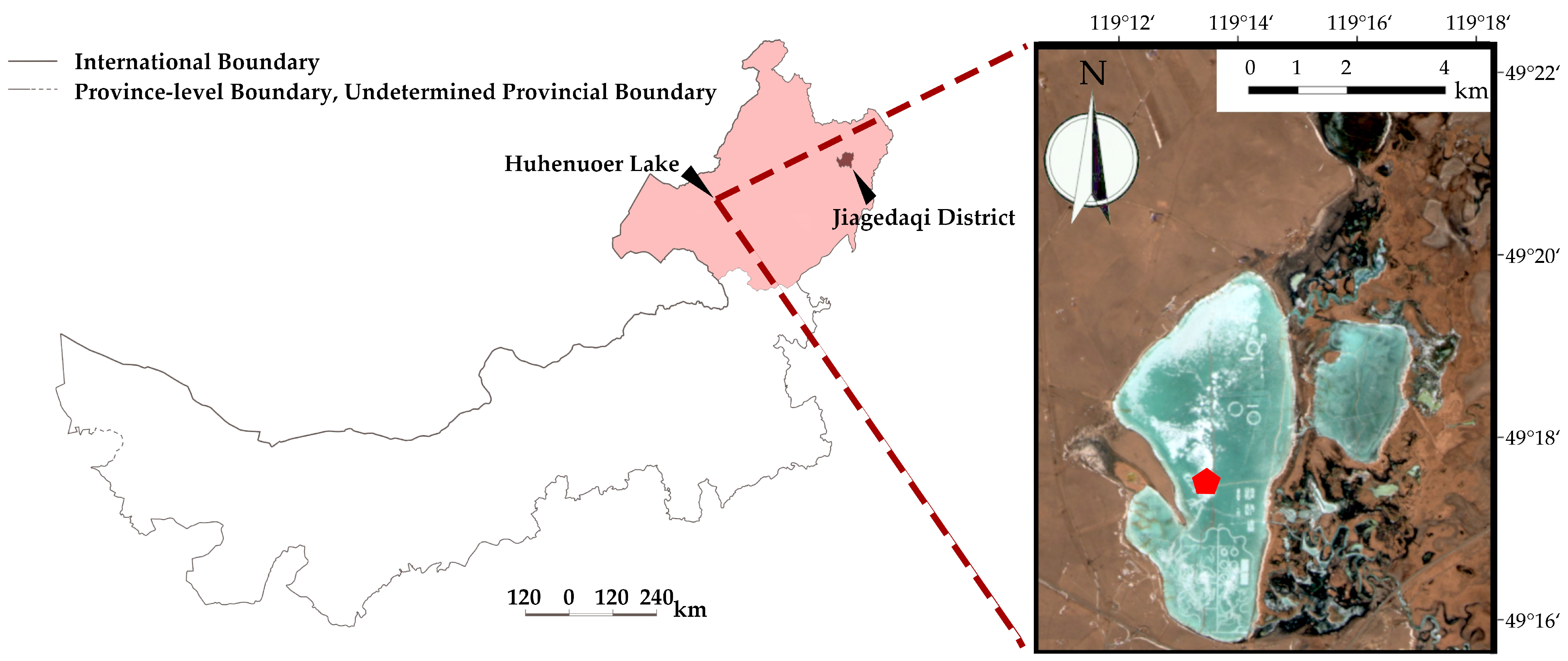

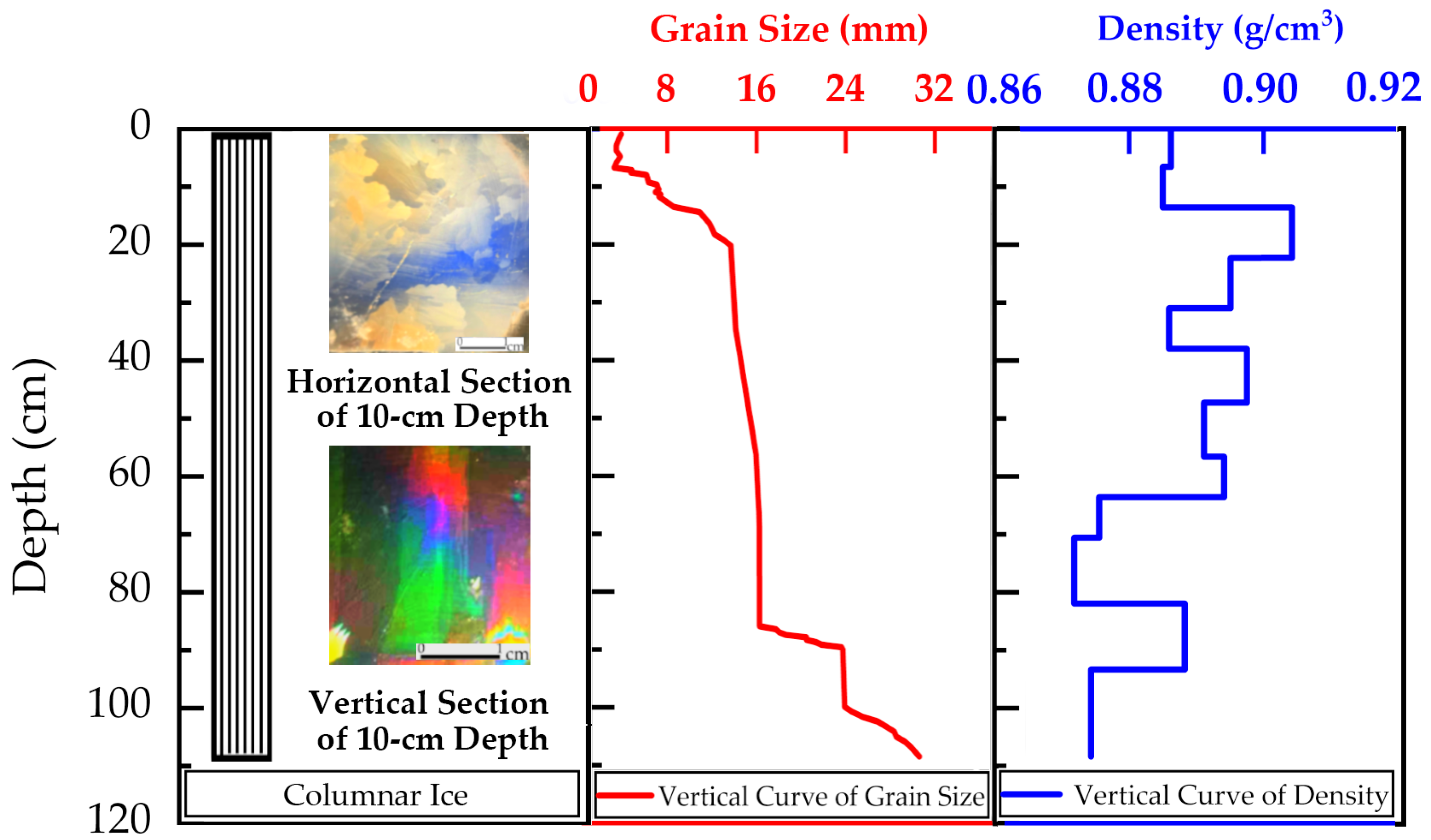
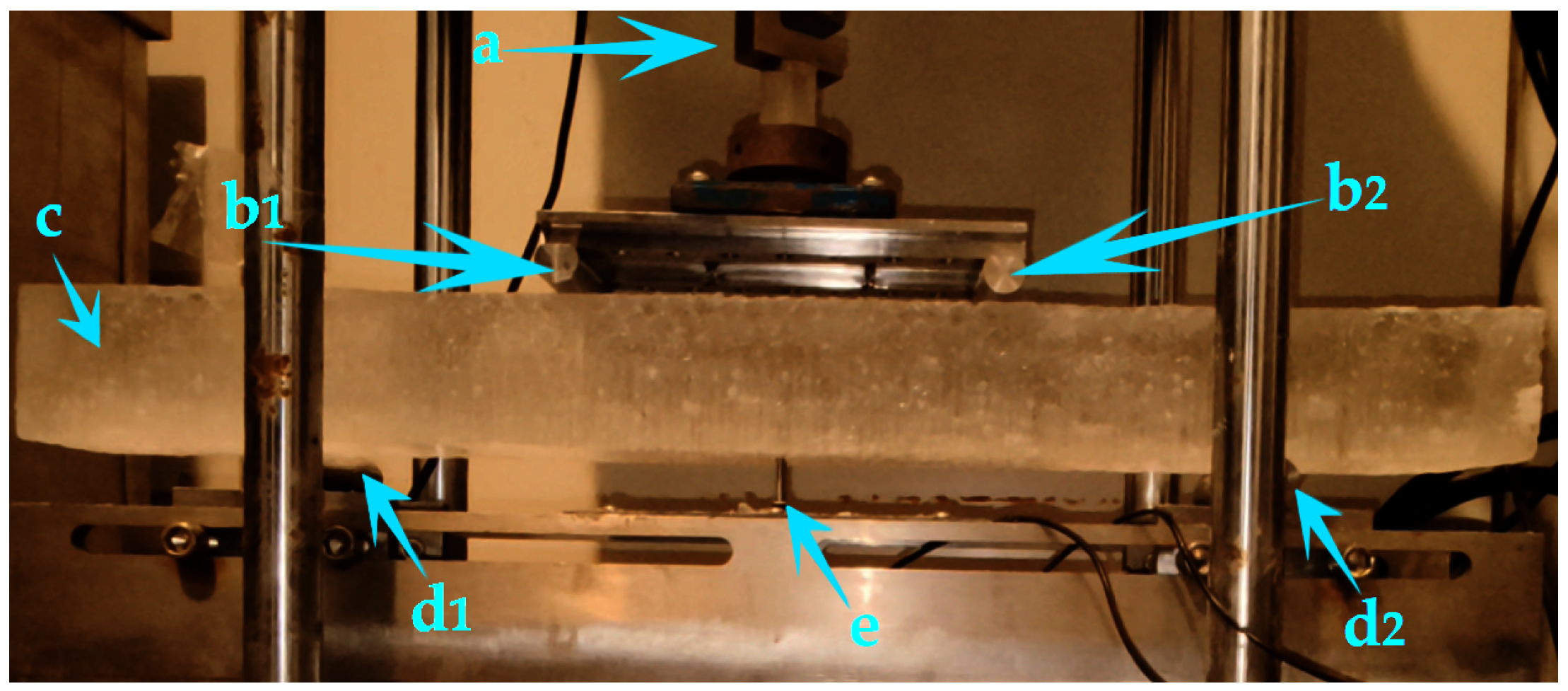
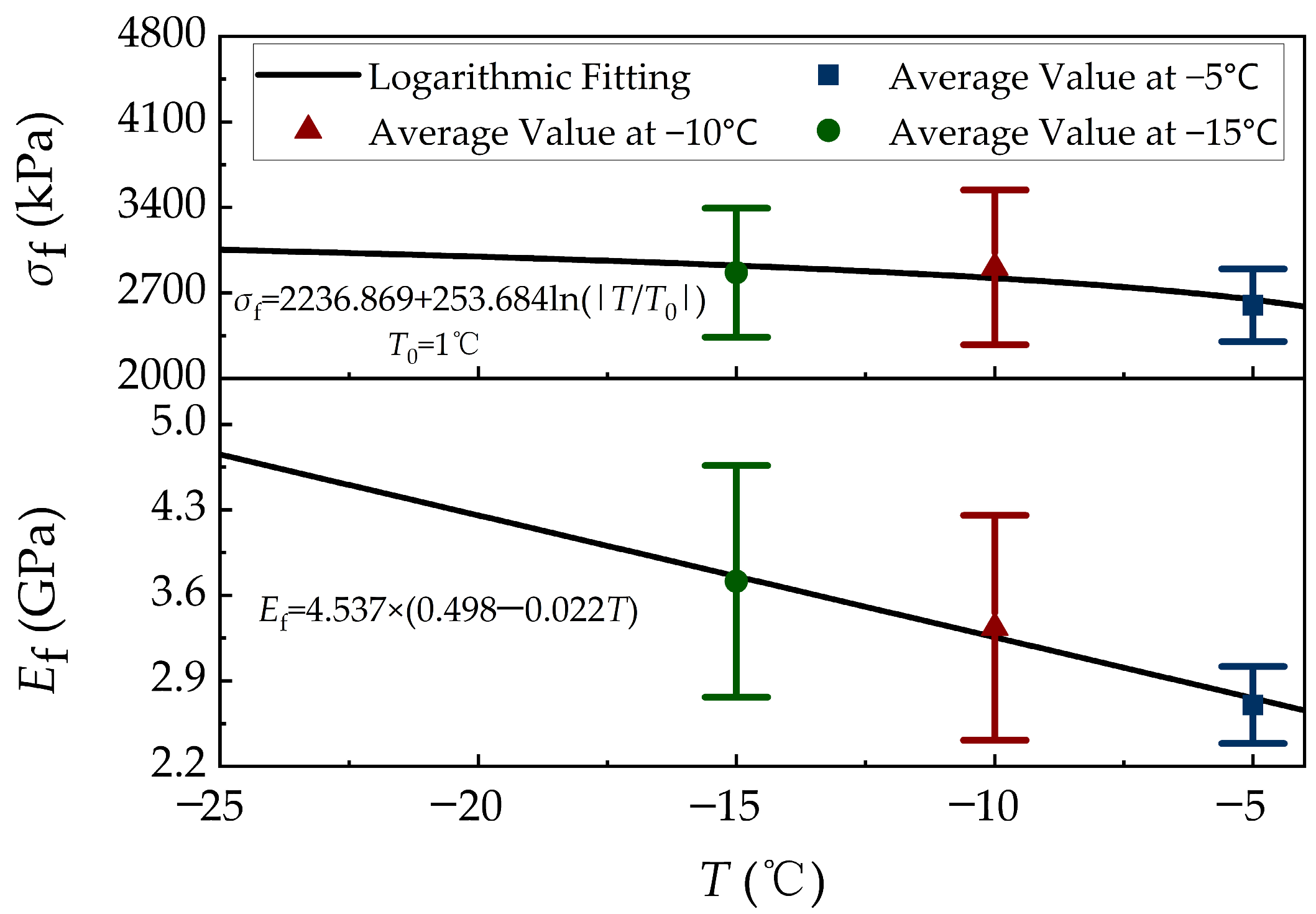
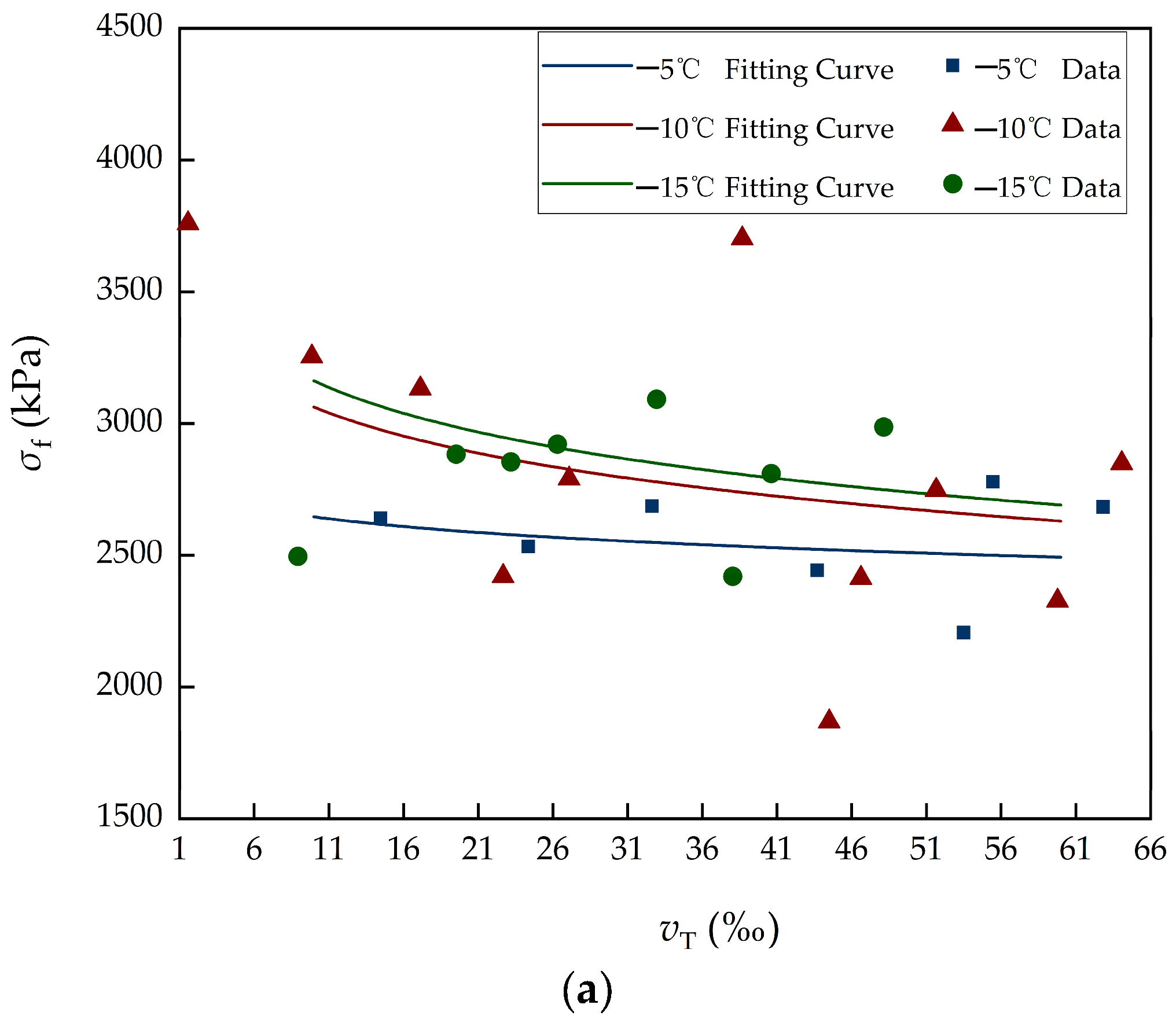


| Test Number | T (°C) | vT (‰) | Ef (GPa) | σf (kPa) | Test Number | T (°C) | vT (‰) | Ef (GPa) | σf (kPa) |
|---|---|---|---|---|---|---|---|---|---|
| 1 | −5 | 14.47 | 3.06 | 2641 | 26 | −10 | 37.65 | 2.93 | 4311 |
| 2 | −5 | 24.35 | 2.52 | 2534 | 27 | −10 | 39.68 | 3.40 | 3095 |
| 3 | −5 | 31.62 | 2.86 | 3227 | 28 | −10 | 44.49 | 2.56 | 1869 |
| 4 | −5 | 33.64 | 2.89 | 2147 | 29 | −10 | 46.61 | 3.48 | 2414 |
| 5 | −5 | 43.27 | 2.94 | 2329 | 30 | −10 | 51.65 | 3.43 | 2749 |
| 6 | −5 | 43.84 | 2.44 | 2704 | 31 | −10 | 59.78 | 3.00 | 2328 |
| 7 | −5 | 43.96 | 2.23 | 2297 | 32 | −10 | 64.08 | 4.05 | 2850 |
| 8 | −5 | 53.49 | 2.78 | 2206 | 33 | −15 | 8.93 | 4.59 | 2496 |
| 9 | −5 | 55.03 | 2.59 | 2707 | 34 | −15 | 19.53 | 3.50 | 2884 |
| 10 | −5 | 55.56 | 2.26 | 2795 | 35 | −15 | 22.37 | 3.33 | 3144 |
| 11 | −5 | 55.82 | 2.50 | 2835 | 36 | −15 | 24.01 | 2.42 | 2566 |
| 12 | −5 | 62.57 | 2.78 | 2707 | 37 | −15 | 25.03 | 5.31 | 2187 |
| 13 | −5 | 63.08 | 3.31 | 2660 | 38 | −15 | 25.31 | 4.42 | 2756 |
| 14 | −10 | 1.58 | 5.92 | 3761 | 39 | −15 | 26.23 | 2.02 | 3629 |
| 15 | −10 | 9.78 | 3.76 | 3428 | 40 | −15 | 28.61 | 3.34 | 3117 |
| 16 | −10 | 9.95 | 4.23 | 3082 | 41 | −15 | 31.90 | 4.52 | 2934 |
| 17 | −10 | 15.12 | 2.15 | 2843 | 42 | −15 | 32.46 | 3.98 | 3649 |
| 18 | −10 | 16.16 | 3.08 | 3682 | 43 | −15 | 33.29 | 4.21 | 3037 |
| 19 | −10 | 17.60 | 3.89 | 2597 | 44 | −15 | 34.08 | 2.85 | 2749 |
| 20 | −10 | 19.62 | 3.39 | 3411 | 45 | −15 | 36.12 | 5.05 | 1650 |
| 21 | −10 | 20.25 | 3.58 | 2498 | 46 | −15 | 39.96 | 3.55 | 3190 |
| 22 | −10 | 23.15 | 3.94 | 2930 | 47 | −15 | 40.32 | 3.51 | 3043 |
| 23 | −10 | 24.62 | 2.23 | 1835 | 48 | −15 | 40.91 | 2.83 | 2577 |
| 24 | −10 | 26.01 | 2.46 | 2479 | 49 | −15 | 47.10 | 2.67 | 2311 |
| 25 | −10 | 28.15 | 1.92 | 3103 | 50 | −15 | 49.17 | 4.78 | 3663 |
| T (°C) | a | c | d | f | g |
|---|---|---|---|---|---|
| −5 | 3189.421 | −0.381 | 0.155 | 2.381 | −0.044 |
| −10 | 5435.256 | −1.051 | 0.132 | 2.380 | −0.110 |
| −15 | 7273.751 | −1.313 | 0.099 | 2.537 | −0.106 |
| An-2 | Bombardier Q400 | Gulfstream G650ER | |
|---|---|---|---|
| Average of daily mean air temperature over all conservative operational periods (°C) | −25.2 | −20.4 | −17.9 |
| Standard deviation of daily mean air temperature over all conservative operational periods (°C) | 5.5 | 5.9 | 5.8 |
| An-2 | Bombardier Q400 | Gulfstream G650ER | |
|---|---|---|---|
| Design air temperature (°C) | −19.7 | −14.5 | −12.1 |
| Design ice temperature (°C) | −9.8 | −7.2 | −6.0 |
| Design flexural strength (kPa) | 2800 | 2700 | 2600 |
| Design effective flexural elastic modulus (GPa) | 3.24 | 2.98 | 2.86 |
| Design ice thickness (cm) | 30 | 70 | 80 |
Disclaimer/Publisher’s Note: The statements, opinions and data contained in all publications are solely those of the individual author(s) and contributor(s) and not of MDPI and/or the editor(s). MDPI and/or the editor(s) disclaim responsibility for any injury to people or property resulting from any ideas, methods, instructions or products referred to in the content. |
© 2025 by the authors. Licensee MDPI, Basel, Switzerland. This article is an open access article distributed under the terms and conditions of the Creative Commons Attribution (CC BY) license (https://creativecommons.org/licenses/by/4.0/).
Share and Cite
Zhao, Q.; Zhang, B.; Wang, Y.; Xu, L.; Li, Z.; Li, Y.; Gong, X.; Bao, X.; He, J.; Wang, Q.; et al. Ice Flexural Properties Using Four-Point Bending Test for the Ice Runway at Huhenuoer Lake. Water 2025, 17, 3363. https://doi.org/10.3390/w17233363
Zhao Q, Zhang B, Wang Y, Xu L, Li Z, Li Y, Gong X, Bao X, He J, Wang Q, et al. Ice Flexural Properties Using Four-Point Bending Test for the Ice Runway at Huhenuoer Lake. Water. 2025; 17(23):3363. https://doi.org/10.3390/w17233363
Chicago/Turabian StyleZhao, Qiuming, Bo Zhang, Ying Wang, Liping Xu, Zhixing Li, Yaodong Li, Xuhui Gong, Xinghua Bao, Jiahuan He, Qingkai Wang, and et al. 2025. "Ice Flexural Properties Using Four-Point Bending Test for the Ice Runway at Huhenuoer Lake" Water 17, no. 23: 3363. https://doi.org/10.3390/w17233363
APA StyleZhao, Q., Zhang, B., Wang, Y., Xu, L., Li, Z., Li, Y., Gong, X., Bao, X., He, J., Wang, Q., & Lu, P. (2025). Ice Flexural Properties Using Four-Point Bending Test for the Ice Runway at Huhenuoer Lake. Water, 17(23), 3363. https://doi.org/10.3390/w17233363






